
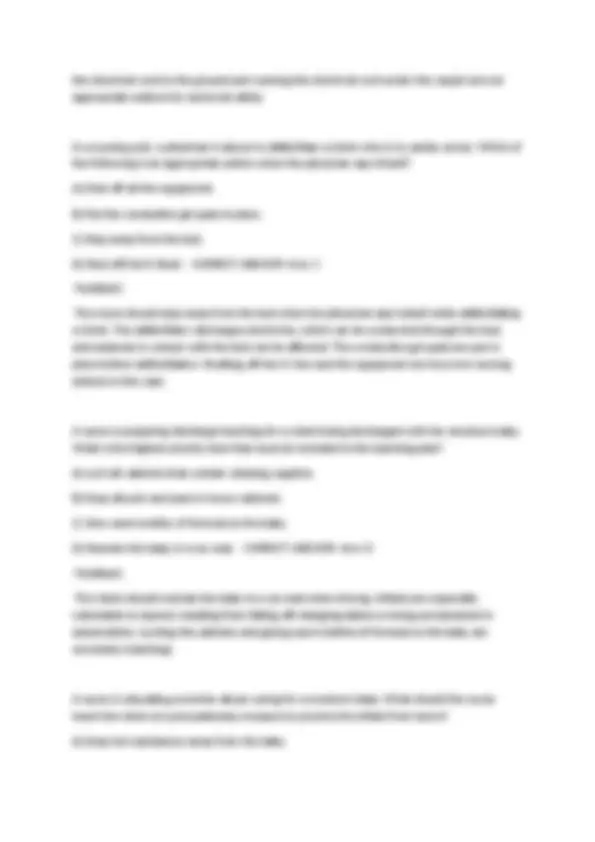
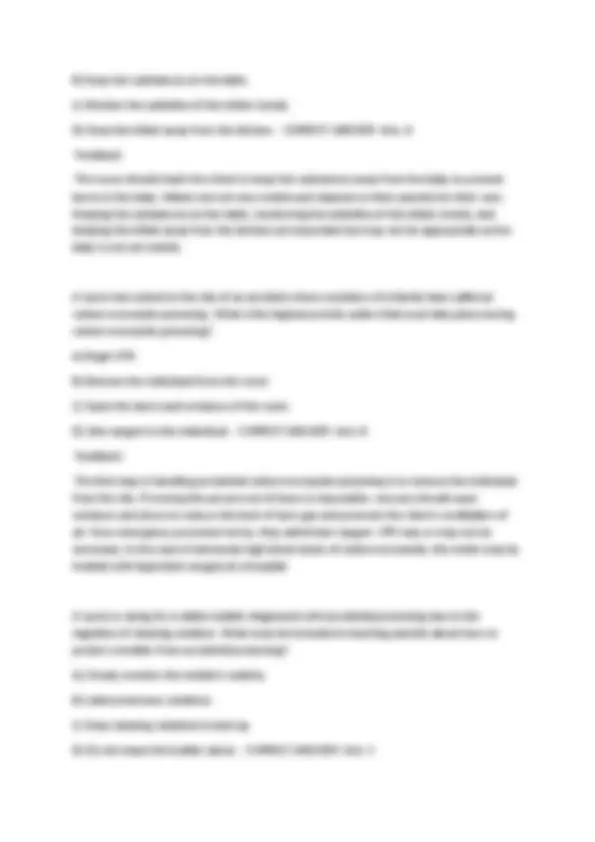
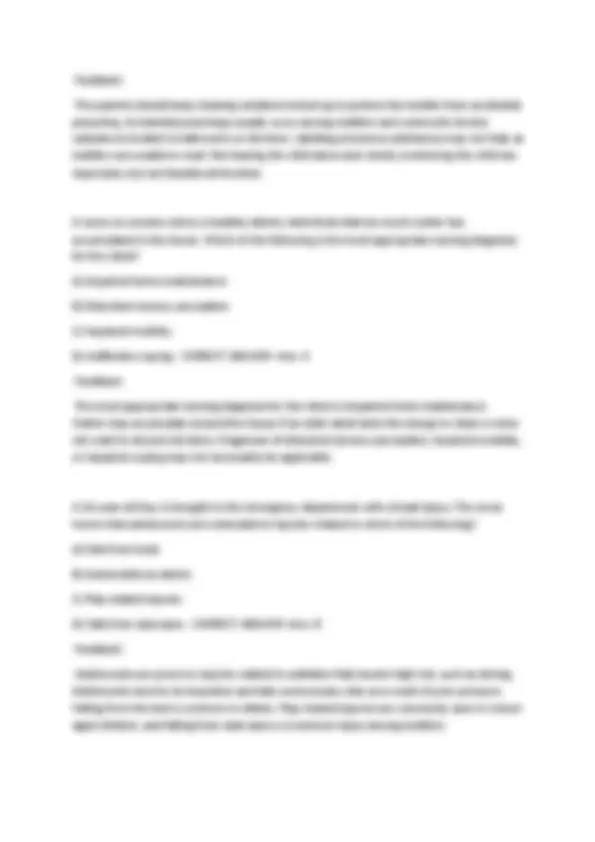
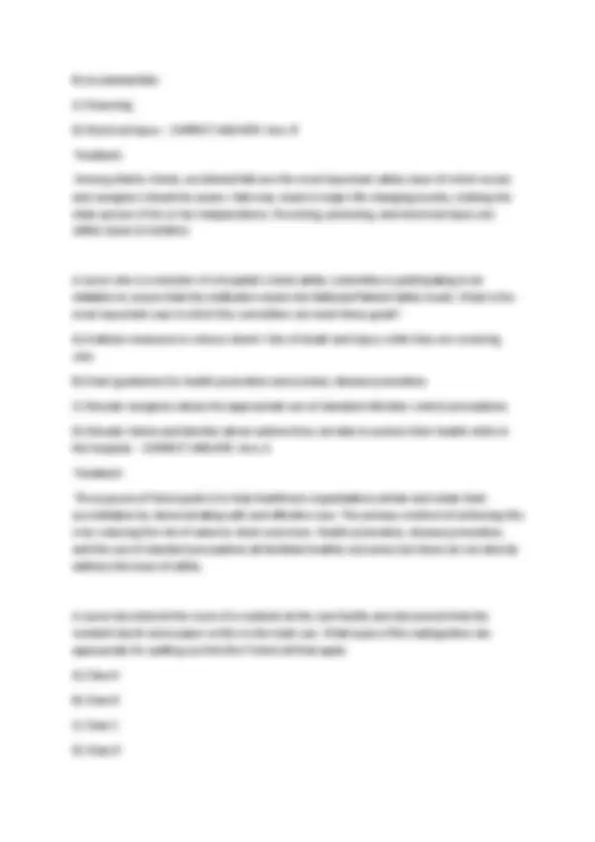
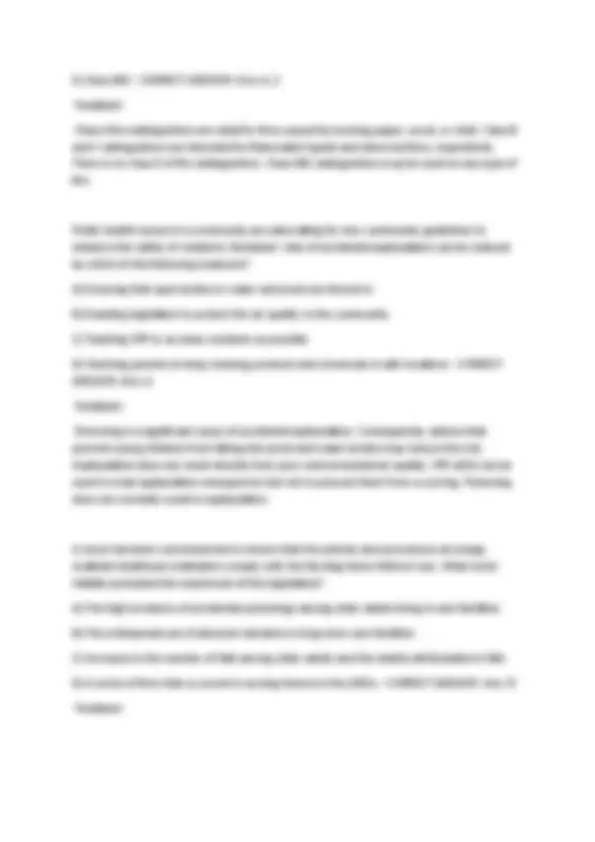
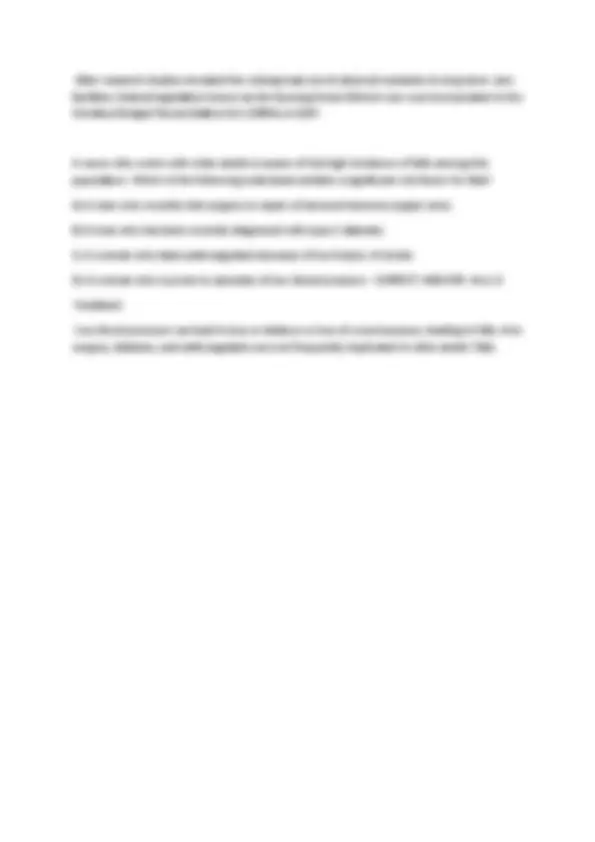


Study with the several resources on Docsity

Earn points by helping other students or get them with a premium plan


Prepare for your exams
Study with the several resources on Docsity

Earn points to download
Earn points by helping other students or get them with a premium plan
Community
Ask the community for help and clear up your study doubts
Discover the best universities in your country according to Docsity users
Free resources
Download our free guides on studying techniques, anxiety management strategies, and thesis advice from Docsity tutors
CHAPTER 19 SAFETY QUESTIONS A nurse is caring for a 10-month-old child who has had surgery for a cleft palate. The child is put in elbow restraints. The mother comes and asks the nurse to remove the restraints. Which of the following is the most appropriate action for the nurse to take? A) Remove a restraint from one extremity. B) Remove both the restraints from the elbows for the remainder of the day. C) Loosen the restraints without removing them. D) Tell the mother that the restraints are important. - CORRECT ANSWER -Ans: A Feedback: The nurse should remove a restraint from one elbow. The elbow restraint in the child is used to prevent the child from touching the incision site. One restraint at a time can be removed to provide movement in the child, but the mother should be told to supervise the child. Removing both the restraints, not removing the restraints, and
Typology: Exams
1 / 10

This page cannot be seen from the preview
Don't miss anything!







A nurse is caring for a 10-month-old child who has had surgery for a cleft palate. The child is put in elbow restraints. The mother comes and asks the nurse to remove the restraints. Which of the following is the most appropriate action for the nurse to take? A) Remove a restraint from one extremity. B) Remove both the restraints from the elbows for the remainder of the day. C) Loosen the restraints without removing them. D) Tell the mother that the restraints are important. - CORRECT ANSWER - Ans: A Feedback: The nurse should remove a restraint from one elbow. The elbow restraint in the child is used to prevent the child from touching the incision site. One restraint at a time can be removed to provide movement in the child, but the mother should be told to supervise the child. Removing both the restraints, not removing the restraints, and loosening the restraints are inappropriate nursing actions. A nurse responds to the call bell and finds another nurse evacuating the client from the room because a garbage can has caught fire. Which of the following actions should the nurse take first? A) Evacuate the unit. B) Pull the fire alarm lever. C) Confine the fire. D) Extinguish the fire. - CORRECT ANSWER - Ans: B Feedback: The nurse should pull the fire alarm lever. As per the RACE principle of fire management, the flow of activities should be rescue, alarm, confine, and extinguish. The client had already been evacuated by another nurse, so the next action should be to pull the fire alarm lever, followed by confinement of the fire and extinguishing. A nurse is caring for an elderly client at risk of injury due to confusion. The client has a stable gait. Which of the following measures should the nurse first take?
A) Waist restraint B) Locking lap tray chair C) Alarm-activating bracelet D) Vest restraint - CORRECT ANSWER - Ans: C Feedback: The nurse should use an alarm-activating bracelet for the client because the client has a stable gait. This prevents unnecessary confinement to bed, and the client can move freely without getting off the premises. Waist restraints, vest restraints, and chair restraints are restrictive, and their use should be minimal. A nurse visits an elderly client at home and assesses the safety of the client's environment. Which of the following poses the greatest threat to the client's safety? A) A laundry bag at the corner of the room B) Skid-resistant small area rugs on the floor C) Area rugs kept on the stairs without carpet D) Carpet on the floor of the living room - CORRECT ANSWER - Ans: C Feedback: The area rugs kept on the stairs are a health hazard and may cause falls. The elderly client should remove the area rugs from the stairs to prevent accidental injury. Laundry bags, skid- resistant small area rugs, and carpets are not harmful. A nurse is caring for a client who is receiving an intravenous therapy at home through an IV pump. Which of the following interventions should the nurse implement to ensure electrical safety? A) Ensure a three-prong grounded plug is used. B) Use an extension cord to provide freedom of movement. C) Tape the electrical cord of the pump to the floor. D) Run the electrical cord of the pump under the carpet. - CORRECT ANSWER - Ans: A Feedback: The nurse should obtain a three-prong grounded plug adapter, as it carries any stray electricity back to the ground. Using an extension cord may be an electrical hazard. Taping
B) Keep hot substances on the table. C) Monitor the activities of the infant closely. D) Keep the infant away from the kitchen. - CORRECT ANSWER - Ans: A Feedback: The nurse should teach the client to keep hot substances away from the baby to prevent burns in the baby. Infants are not very mobile and depend on their parents for their care. Keeping hot substances on the table, monitoring the activities of the infant closely, and keeping the infant away from the kitchen are important but may not be appropriate as the baby is not yet mobile. A nurse has rushed to the site of an accident where members of a family have suffered carbon monoxide poisoning. What is the highest priority action that must take place during carbon monoxide poisoning? A) Begin CPR. B) Remove the individual from the room. C) Open the doors and windows of the room. D) Give oxygen to the individual. - CORRECT ANSWER - Ans: B Feedback: The first step in handling accidental carbon monoxide poisoning is to remove the individual from the site. If moving the person out of doors is impossible, rescuers should open windows and doors to reduce the level of toxic gas and promote the client's ventilation of air. Once emergency personnel arrive, they administer oxygen. CPR may or may not be necessary. In the case of extremely high blood levels of carbon monoxide, the victim may be treated with hyperbaric oxygen at a hospital. A nurse is caring for a stable toddler diagnosed with accidental poisoning due to the ingestion of cleaning solution. What must be included in teaching parents about how to protect a toddler from accidental poisoning? A) Closely monitor the toddler's activity. B) Label poisonous solutions. C) Keep cleaning solutions locked up. D) Do not leave the toddler alone. - CORRECT ANSWER - Ans: C
Feedback: The parents should keep cleaning solutions locked up to protect the toddler from accidental poisoning. Accidental poisonings usually occur among toddlers and commonly involve substances located in bathrooms or kitchens. Labeling poisonous substances may not help as toddlers are unable to read. Not leaving the child alone and closely monitoring the child are important, but not feasible all the time. A nurse on a home visit to a healthy elderly client finds that too much clutter has accumulated in the house. Which of the following is the most appropriate nursing diagnosis for the client? A) Impaired home maintenance B) Disturbed sensory perception C) Impaired mobility D) Ineffective coping - CORRECT ANSWER - Ans: A Feedback: The most appropriate nursing diagnosis for the client is impaired home maintenance. Clutter may accumulate around the house if an older adult lacks the energy to clean or does not want to discard old items. Diagnoses of disturbed sensory perception, impaired mobility, or impaired coping may not necessarily be applicable. A 16-year-old boy is brought to the emergency department with a head injury. The nurse knows that adolescents are vulnerable to injuries related to which of the following? A) Falls from beds B) Automobile accidents C) Play-related injuries D) Falls from staircases - CORRECT ANSWER - Ans: B Feedback: Adolescents are prone to injuries related to activities that involve high risk, such as driving. Adolescents tend to be impulsive and take unnecessary risks as a result of peer pressure. Falling from the bed is common in infants. Play-related injuries are commonly seen in school- aged children, and falling from staircases is a common injury among toddlers.
Feedback: The parents should not leave the toddler for an unattended bath. Toddlers are naturally inquisitive, and instructing them to stay away from the pool or teaching them that water is dangerous is insufficient to ensure safety. An unconscious client is brought to the emergency department after ingesting too much prescribed medication. Which of the following is the highest priority nursing intervention? A) Call family members. B) Establish IV access. C) Administer antacids. D) Establish a patent airway. - CORRECT ANSWER - Ans: D Feedback: Initial treatment for a victim of suspected poisoning involves maintaining breathing and cardiac function. This is a priority over communication with the family, establishing IV access or administering other medications. A nurse needs to restrain a client who may be harmful to himself. Which of the following is the priority nursing action when applying restraints? A) Take a physician's order for restraining. B) Administer chemical restraints. C) Put padding below the restraint. D) Reassess the client's condition regularly. - CORRECT ANSWER - Ans: A Feedback: The nurse should get a physician's order for using restraints on the client. Administering chemical restraints without a physician's order is illegal. Putting a pad below the restraint is important, but only after getting an order from the physician. Reassessing the client's condition is important during a restraint, but only after medical orders. A nurse is caring for elderly clients. Which of the following is the most significant safety threat to older clients? A) Drowning
B) Accidental falls C) Poisoning D) Electrical injury - CORRECT ANSWER - Ans: B Feedback: Among elderly clients, accidental falls are the most important safety issue of which nurses and caregivers should be aware. Falls may result in major life-changing events, robbing the older person of his or her independence. Drowning, poisoning, and electrical injury are safety issues in toddlers. A nurse who is a member of a hospital's client safety committee is participating in an initiative to ensure that the institution meets the National Patient Safety Goals. What is the most important way in which this committee can meet these goals? A) Institute measures to reduce clients' risks of death and injury while they are receiving care. B) Enact guidelines for health promotion and primary disease prevention. C) Educate caregivers about the appropriate use of standard infection control precautions. D) Educate clients and families about actions they can take to protect their health while in the hospital. - CORRECT ANSWER - Ans: A Feedback: The purpose of these goals is to help healthcare organizations obtain and retain their accreditation by demonstrating safe and effective care. The primary method of achieving this is by reducing the risk of adverse client outcomes. Health promotion, disease prevention, and the use of standard precautions all facilitate healthy outcomes but these do not directly address the issue of safety. A nurse has entered the room of a resident at the care facility and discovered that the resident has lit some paper on fire in the trash can. What types of fire extinguisher are appropriate for putting out this fire? Select all that apply A) Class A B) Class B C) Class C D) Class D
After research studies revealed the widespread use of physical restraints in long-term care facilities, federal legislation known as the Nursing Home Reform Law was incorporated in the Omnibus Budget Reconciliation Act (OBRA) in 1987. A nurse who works with older adults is aware of the high incidence of falls among this population. Which of the following individuals exhibits a significant risk factor for falls? A) A man who recently had surgery to repair a fractured humerus (upper arm) B) A man who has been recently diagnosed with type 2 diabetes C) A woman who takes anticoagulants because of her history of stroke D) A woman who is prone to episodes of low blood pressure - CORRECT ANSWER - Ans: D Feedback: Low blood pressure can lead to loss or balance or loss of consciousness, leading to falls. Arm surgery, diabetes, and anticoagulants are not frequently implicated in older adults' falls.